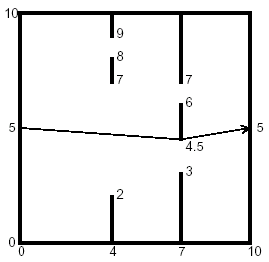poj 1556 The Doors (bellman+几何)
来源:互联网 发布:ajax数据返回测试工具 编辑:程序博客网 时间:2024/04/29 16:04
The Doors
Time Limit: 1000MS Memory Limit: 10000KTotal Submissions: 6294 Accepted: 2530
Description
You are to find the length of the shortest path through a chamber containing obstructing walls. The chamber will always have sides at x = 0, x = 10, y = 0, and y = 10. The initial and final points of the path are always (0, 5) and (10, 5). There will also be from 0 to 18 vertical walls inside the chamber, each with two doorways. The figure below illustrates such a chamber and also shows the path of minimal length.


Input
The input data for the illustrated chamber would appear as follows.
2
4 2 7 8 9
7 3 4.5 6 7
The first line contains the number of interior walls. Then there is a line for each such wall, containing five real numbers. The first number is the x coordinate of the wall (0 < x < 10), and the remaining four are the y coordinates of the ends of the doorways in that wall. The x coordinates of the walls are in increasing order, and within each line the y coordinates are in increasing order. The input file will contain at least one such set of data. The end of the data comes when the number of walls is -1.
2
4 2 7 8 9
7 3 4.5 6 7
The first line contains the number of interior walls. Then there is a line for each such wall, containing five real numbers. The first number is the x coordinate of the wall (0 < x < 10), and the remaining four are the y coordinates of the ends of the doorways in that wall. The x coordinates of the walls are in increasing order, and within each line the y coordinates are in increasing order. The input file will contain at least one such set of data. The end of the data comes when the number of walls is -1.
Output
The output should contain one line of output for each chamber. The line should contain the minimal path length rounded to two decimal places past the decimal point, and always showing the two decimal places past the decimal point. The line should contain no blanks.
Sample Input
15 4 6 7 824 2 7 8 97 3 4.5 6 7-1
Sample Output
10.0010.06
有些点中间有墙不能连线,故要挨个判断,然后建图,用最短路解决。
</pre><pre name="code" class="cpp">#include"stdio.h"#include"string.h"#include"math.h"#include"iostream"#include"algorithm"using namespace std;#define LL __int64#define N 100#define M 1000005const double inf=1e10;#define max(a,b) (a>b?a:b)struct point //存储点坐标{ double x,y;}p[N];struct edge //存储边信息{ int u,v;}e[N*N];int i,j,n,psize,esize;double wx[20]; //存储每堵墙的X坐标double g[N][N]; //邻接矩阵double py[20][4];double d[N];double Dis(point a,point b){ return sqrt((a.x-b.x)*(a.x-b.x)+(a.y-b.y)*(a.y-b.y));}//判断点(x3,y3)是否位于点(x1,y1)和(x2,y2)所确定直线的上方还是下方 //返回值>0表示 (x3,y3)位于直线上方(逆时针方向),<0表示位于下方 (顺时针方向) double Cross(double x1,double y1,double x2,double y2,double x3,double y3){ return (x2-x1)*(y3-y1)-(x3-x1)*(y2-y1);}bool Isok(point a,point b){ if(a.x>=b.x) return false; int i=0; while(wx[i]<=a.x&&i<n) i++; while(wx[i]<b.x&&i<n) { if(Cross(a.x,a.y,b.x,b.y,wx[i],0)*Cross(a.x,a.y,b.x,b.y,wx[i],py[i][0])<0 ||Cross(a.x,a.y,b.x,b.y,wx[i],py[i][1])*Cross(a.x,a.y,b.x,b.y,wx[i],py[i][2])<0 ||Cross(a.x,a.y,b.x,b.y,wx[i],py[i][3])*Cross(a.x,a.y,b.x,b.y,wx[i],10)<0) { return false; } i++; } return true;}void Bellman(){ int i,j; for(i=0;i<psize;i++) d[i]=inf; d[0]=0; bool ff=true; int u,v; for(i=0;i<psize&&ff;i++) { ff=false; for(j=0;j<esize;j++) { u=e[j].u; v=e[j].v; if(d[u]<inf&&d[u]+g[u][v]<d[v]) { d[v]=d[u]+g[u][v]; ff=true; } } } printf("%.2f\n",d[psize-1]);}void solve(){ int i,j; p[0].x=0; p[0].y=5; psize=1; for(i=0;i<n;i++) { scanf("%lf",&wx[i]); for(j=0;j<4;j++) { p[psize].x=wx[i]; scanf("%lf",&py[i][j]); p[psize++].y=py[i][j]; } } p[psize].x=10; p[psize++].y=5; for(i=0;i<psize;i++) { for(j=0;j<psize;j++) g[i][j]=inf; } esize=0; for(i=0;i<psize;i++) { for(j=i+1;j<psize;j++) { if(Isok(p[i],p[j])) { g[i][j]=Dis(p[i],p[j]); e[esize].u=i; e[esize++].v=j; } } } Bellman();}int main(){ while(scanf("%d",&n)!=-1) { if(n==-1) break; solve(); } return 0;} 0 0
- poj 1556 The Doors (bellman+几何)
- poj 1556 The Doors(计算几何)
- POJ 1556 The Doors(计算几何+Floyd)
- poj 1556 The Doors(最短路+计算几何)
- POJ 1556 The Doors(Dijkstra+计算几何)
- POJ 1556 The Doors(几何+最短路)
- 【计算几何】 POJ 1556 The Doors
- POJ 1556 The Doors --几何,最短路
- poj 1556 The Doors(几何+最短路)
- POJ 1556 The Doors 计算几何+MST
- poj 1556 The Doors(最短路+几何)
- POJ 1556 The Doors (计算几何+dij最短路)
- POJ 1556 The Doors 计算几何+ 最短路
- POJ 1556 The Doors(计算几何+最短路)
- poj 1556 The Doors
- poj 1556 The Doors
- POJ 1556 The Doors
- poj 1556 The Doors
- 第六周总结
- 《TCP/IP详解卷》读书笔记(一):概览TCP/IP协议族
- 第七周总结
- [清华大学]计算机科学与技术
- lcs
- poj 1556 The Doors (bellman+几何)
- strtok的实现
- 为线程绑定CPU
- Java三大常用数组元素排序法,插入/选择/冒泡
- apache <Directory>下的选项解读
- PAT (Basic Level) Practise (中文)1010. 一元多项式求导 (25)
- Android手机安全之我见
- linux挂载U盘,及乱码问题解决
- MySQL原生HA方案 – Fabric体验之旅


